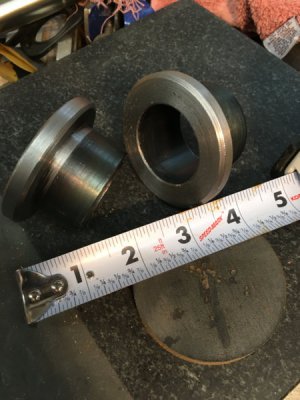- Joined
- Dec 12, 2016
- Messages
- 527
I did this a while back, but figured I'd post the info for others that might be interested.
This setup completely replaces the original Reeves drive and countershaft arrangement. The motor is the original Doerr 2HP 3PH unit. I am using the stock cogged belt size/length, but have fitted the motor with a slightly smaller drive pulley (22T). I redrilled the motor support brackets so they could use the slots previously used for the countershaft support. A piece of 1/2" steel plate is used to get the motor in the correct location, in line with the spindle pulley.
Mechanical parts, from McMaster-Carr:
6495K615 - H Series Quick Disconnect Timing Pulley (1-1/2" wide H series Quick Disconnect 22T)
6086K34 - Quick Disconnect SD 7/8" ID 3/16" keyway
6484K284 - H Series 63" x 1-1/2" Belt (630H150)
99020A420 - 3/16" key stock
VFD is Hitachi WJ200-022SF, from Drive Warehouse. I am using 4 x 50 ohm 100 watt resistors (in series/parallel pairs for 100 ohm total) for braking. Most of the control items are from Automation Direct. The enclosure is good sized (14 x 12 x 8), from factorymation, so does not need a separate fan. I am using a (2) pole motor switch as a disconnect, relatively simple control wiring. The original motor flexible conduit has been rerouted to enter the enclosure, near the top. Everything is mounted to a an aluminum plate which can be removed for service.
The speed control is pricey but industrial quality (Allied: Honeywell 53C11K + Schneider Electric ZB4BD922). The control panel is located where you stand so you can change speed etc. while machining.
Pete
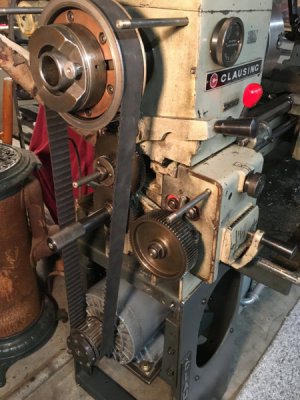
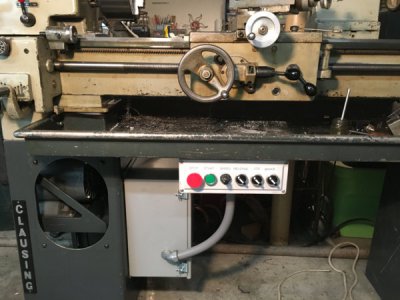
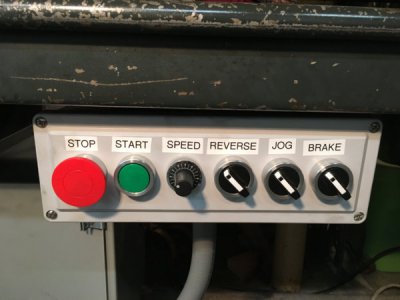
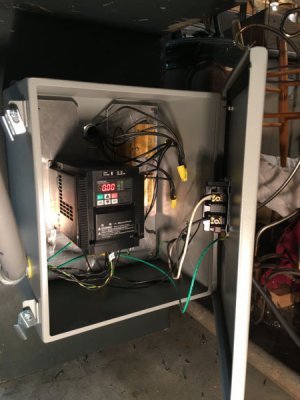
This setup completely replaces the original Reeves drive and countershaft arrangement. The motor is the original Doerr 2HP 3PH unit. I am using the stock cogged belt size/length, but have fitted the motor with a slightly smaller drive pulley (22T). I redrilled the motor support brackets so they could use the slots previously used for the countershaft support. A piece of 1/2" steel plate is used to get the motor in the correct location, in line with the spindle pulley.
Mechanical parts, from McMaster-Carr:
6495K615 - H Series Quick Disconnect Timing Pulley (1-1/2" wide H series Quick Disconnect 22T)
6086K34 - Quick Disconnect SD 7/8" ID 3/16" keyway
6484K284 - H Series 63" x 1-1/2" Belt (630H150)
99020A420 - 3/16" key stock
VFD is Hitachi WJ200-022SF, from Drive Warehouse. I am using 4 x 50 ohm 100 watt resistors (in series/parallel pairs for 100 ohm total) for braking. Most of the control items are from Automation Direct. The enclosure is good sized (14 x 12 x 8), from factorymation, so does not need a separate fan. I am using a (2) pole motor switch as a disconnect, relatively simple control wiring. The original motor flexible conduit has been rerouted to enter the enclosure, near the top. Everything is mounted to a an aluminum plate which can be removed for service.
The speed control is pricey but industrial quality (Allied: Honeywell 53C11K + Schneider Electric ZB4BD922). The control panel is located where you stand so you can change speed etc. while machining.
Pete




Last edited:

